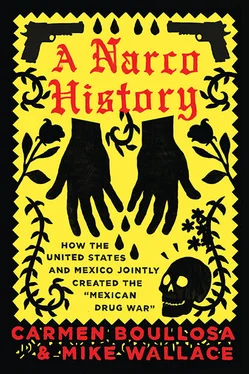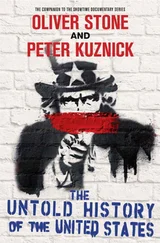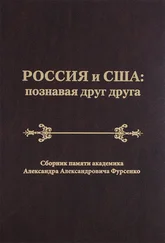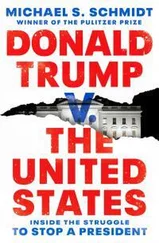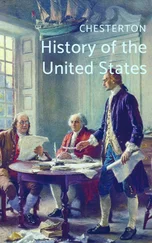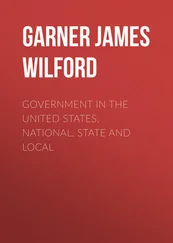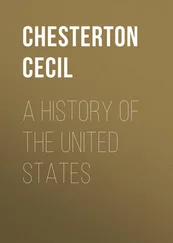


The mayor and his wife were not people to trifle with. Abarca was closely linked to a violent drug trafficking gang, the Guerreros Unidos (“United Warriors”), which had been a military arm of the once powerful Beltrán Leyva Organization. When the latter collapsed in 2009, leaving the Guerreros to their own devices, they took over the production and processing of opium paste (the base for making heroin) and shipped it directly to Chicago, secreted in commercial passenger buses. The Guerreros Unidos supplemented this income stream with collateral criminality, notably kidnapping and extortion, both in Iguala itself — where they were notorious for donning masks at night and grabbing people on the street and giving them an hour to come up with $1000—and throughout Guerrero. They also did battle with other fragments of the progenitor Beltrán Leyva cartel, notably a gang called Los Rojos (The Reds), for control of the drug trafficking business in Guerrero. Their incessant shootouts, which filled mass graves in the countryside, helped drive the state’s murder rate to sixty-three for every one hundred thousand inhabitants, approaching that of Honduras, the homicide capital of the world.
Abarca’s principal connection to the Guerreros came courtesy of his wife. Pineda came from a family of drug dealers — her father and three brothers had worked with the Beltrán Leyva Organization in its heyday, then became Guerrero warriors (two brothers died in battle in 2009). Federal police opened a case against María de los Ángeles herself in 2010 for “delitos contra la salud” (drug trade — related crimes), but dropped it for reasons unknown.
Abarca had started his business career as a sandal salesman in the local market, but had a meteoric rise. Using mysteriously assembled funds, he became a major property owner, acquiring real estate, jewelry stores, and a shopping mall (the land for which was donated by the Ministry of Defense after intense lobbying on Abarca’s behalf by officials of Guerrero state). He snared the mayoralty in 2012, despite warnings that putting him in office meant turning the city over to organized crime. (One of those protestors was found dead a few weeks after Abarca assumed office). The new mayor proceeded to stuff eleven relatives onto the city payroll. He made his cousin Felipe Flores chief of police, and it was generally believed that the department was now a de facto branch of the Guerreros Unidos, who, in addition to extorting the citizenry, used Iguala as a base for their drug trafficking, and provided the mayor with muscle when needed.
In May 2013, Abarca had turned them loose on local activist Arturo Hernández Cardona, who had led a demonstration in Iguala by aggrieved farmers and miners. According to witnesses, Abarca arranged the kidnapping and torture of Hernández Cardona, and then showed up personally to inform the victim, “You fucked with me, so I will have the pleasure of killing you,” just before shotgunning him to death. The Ayotzinapans, who had had close ties with Hernández Cardona, demonstrated in front of town hall. The local Catholic bishop, Raul Vera, called for an investigation into the killings. He even took the case to human rights organizations in the U.S. — but the authorities decided the mayor was constitutionally immune from prosecution, and nothing was done. Impunity had been formalized. “Butchers have come into power,” Bishop Vera said, and indeed it is very hard to discern where the state ends and the criminals begin.
It is even harder in the case of the mayor’s wife. When she and her husband came to municipal power in 2012, it was María de los Ángeles herself who, according to one of the gang’s leaders, became Iguala’s “key operator,” the organizer of the city’s dark side. In her daylight role as first lady, however, Pineda loved to play Lady Bountiful. She had endless photos taken of herself posing with the beneficiaries of her benevolence. And on September 26, 2014, she was due to give her annual report as president of the local chapter of the National System for Integral Family Development, a state-funded organization. According to many observers, she also intended to use the occasion to launch a campaign to succeed her husband as mayor. The ceremony, held in the downtown Civic Plaza, was to be followed by an open-air party. To ensure an imposing audience, they brought in four thousand acarreados , poor people rewarded for attending and applauding. This gathering was in full swing when word arrived that Ayotzinapa students were once again in town, possibly intent on ruining her big day. The imperious first lady — stylistically a cross between Marie Antoinette and Maleficent (the Disney villain) — spewed abuse about the students, with whom she had crossed swords before: “filthy,” “criminals,” “hustlers,” and “profiteers” were among the sputtered adjectives. Then either she or the mayor gave the order to “Stop them, contain them, and teach them a lesson.”



Meanwhile, back at the terminal, the massed one hundred students discarded the bus with broken window and commandeered two new ones. Sure that the police would be back, they decided to get out of town as fast as possible. The caravan of now four buses proceeded north on a main north-south street, through thickening traffic, heading straight for the Civic Plaza. 1It seems like they intended to make a right turn just before it, and head east to an entrance to the periférico , the circumferential highway that would take them back to Ayotzinapa. Only one bus was able to do so before police cars began pouring into the area. The remaining three vehicles had no choice but to plow straight ahead, past the Plaza, where the event was just breaking up, and make for another entrance to the highway. The police gave chase, running behind and alongside them, shooting in the air, until other patrol cars cut in ahead of the procession, just before the on-ramp, forming a barricade and boxing in the three buses.
Then they began shooting to kill. They were joined in this by reinforcements dispatched by the police department of the neighboring town of Cocula, which was even more a creature of the Guerreros Unidos than was the Iguala department. In addition, two unmarked cars showed up, out of which stepped some masked men in black commando outfits, almost certainly Guerrero members, who began firing bursts from semi-automatic weapons. Several students were killed or wounded, and twenty-five to thirty were rounded up (principally from the last bus in line) and driven off in police vans.
Others scattered into the night, seeking shelter. Some were succored by householders — one elderly woman took in a group of students, a “gentleman” rescued another group — others were spurned. One contingent of students carried a wounded comrade to a nearby clinic. A doctor agreed to call an ambulance. Instead he phoned the army. The 27th Infantry Battalion had a garrison at Iguala, in part to deal with thugs like the Guerreros Unidos, but they proved anything but helpful. Around midnight they showed up in full battle gear, lined the students up against a wall, took their data and photos, confiscated their cell phones, and threatened to turn them over to the municipal police, saying, “You had the balls to stir things up, so have the balls to pay the price.” In the end, however, they let them go.
Читать дальше
